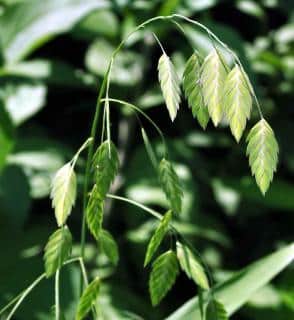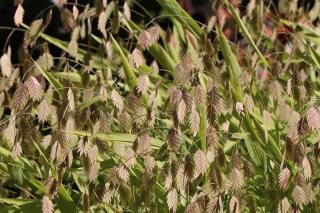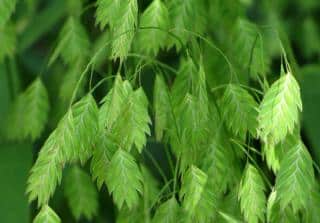

A grass with atypical flowers, Chasmanthium latifolium is a superb grassy perennial.
Chasmanthium latifolium key facts:
Name – Chasmanthium latifolium
Family – Poaceae
Type – Grass
Bearing – arched clump
Height – from 20 inches to over 4 feet (50 to 1.20 cm) upon blooming
Planting density – 3 to 4 plants per sq. yard (m²)
Exposure – sunny to partly sunny
Soil – any type
Flowering – end of the summer
Native to the woody clearings of North America, Chasmanthium latifolium is one of those grasses that is as happy in the shade as it is in full sun. Its summer seed panicles, similar to those of oats, will definitely make your garden feel homely and timeless.
 Even though it can cope with any type of soil, Chasmanthium latifolium particularly loves soil that has lots of humus. Bonus points if it’s also well aerated and drains at least a little bit. To ensure proper growth of this grass, it’s best to follow these few steps before planting.
Even though it can cope with any type of soil, Chasmanthium latifolium particularly loves soil that has lots of humus. Bonus points if it’s also well aerated and drains at least a little bit. To ensure proper growth of this grass, it’s best to follow these few steps before planting.
When growing it in pots, follow the same steps, but also include a drainage layer at the bottom of the pot, to help water drain away.
 As is often the case with grasses, Chasmanthium requires nearly no care at all. Give it 5 minute’s worth of work cutting it back at the beginning of spring so that new shoots can form a beautiful mound before blooming.
As is often the case with grasses, Chasmanthium requires nearly no care at all. Give it 5 minute’s worth of work cutting it back at the beginning of spring so that new shoots can form a beautiful mound before blooming.
Note: if your soil is very poor, add soil mix or compost in spring. Simply spread it on the surface and rake it in lightly. If your Chasmanthium latifolium is in a pot, you’ll have to repot it every 2 to 3 years, more or less.
Of course, its possible to sow the seeds, but the technique that will give you the most control over the end result is clump division:
Chasmanthium latifolium is not vulnerable to disease nor to pests.
 Grasses are most magnificent when paired with other grass species in great numbers in a large flower bed. Chasmanthium latifolium can thus be planted together with:
Grasses are most magnificent when paired with other grass species in great numbers in a large flower bed. Chasmanthium latifolium can thus be planted together with:
This will give you a fantastic grasses bed that you’ll find stunning as seasons come and go.
If you prefer to delve into something more original, try pairing your Chasmanthium latifolium with Liriope muscari, Schizostylis coccinea, Hemerocallis ‘Stafford’ and/or Crocosmia ‘Lucifer’.